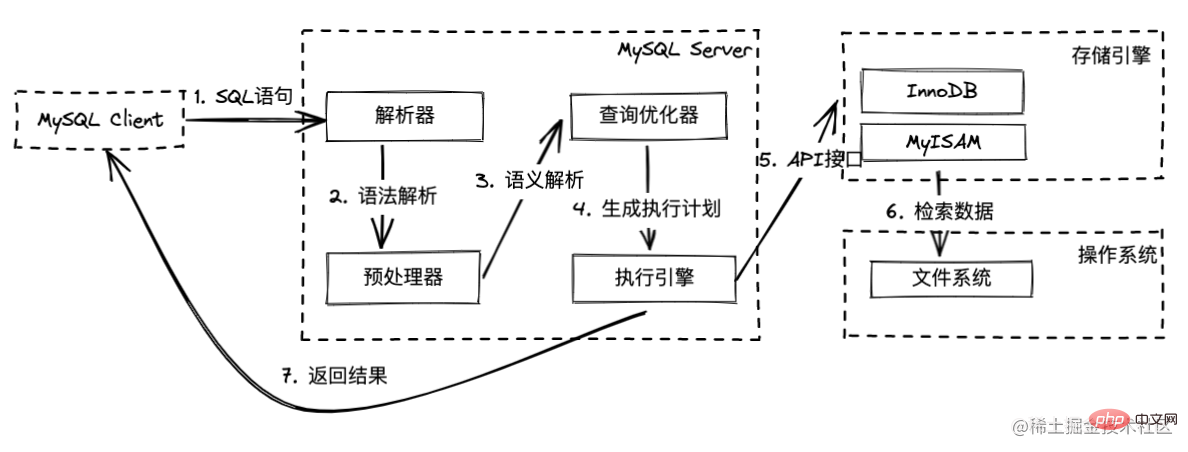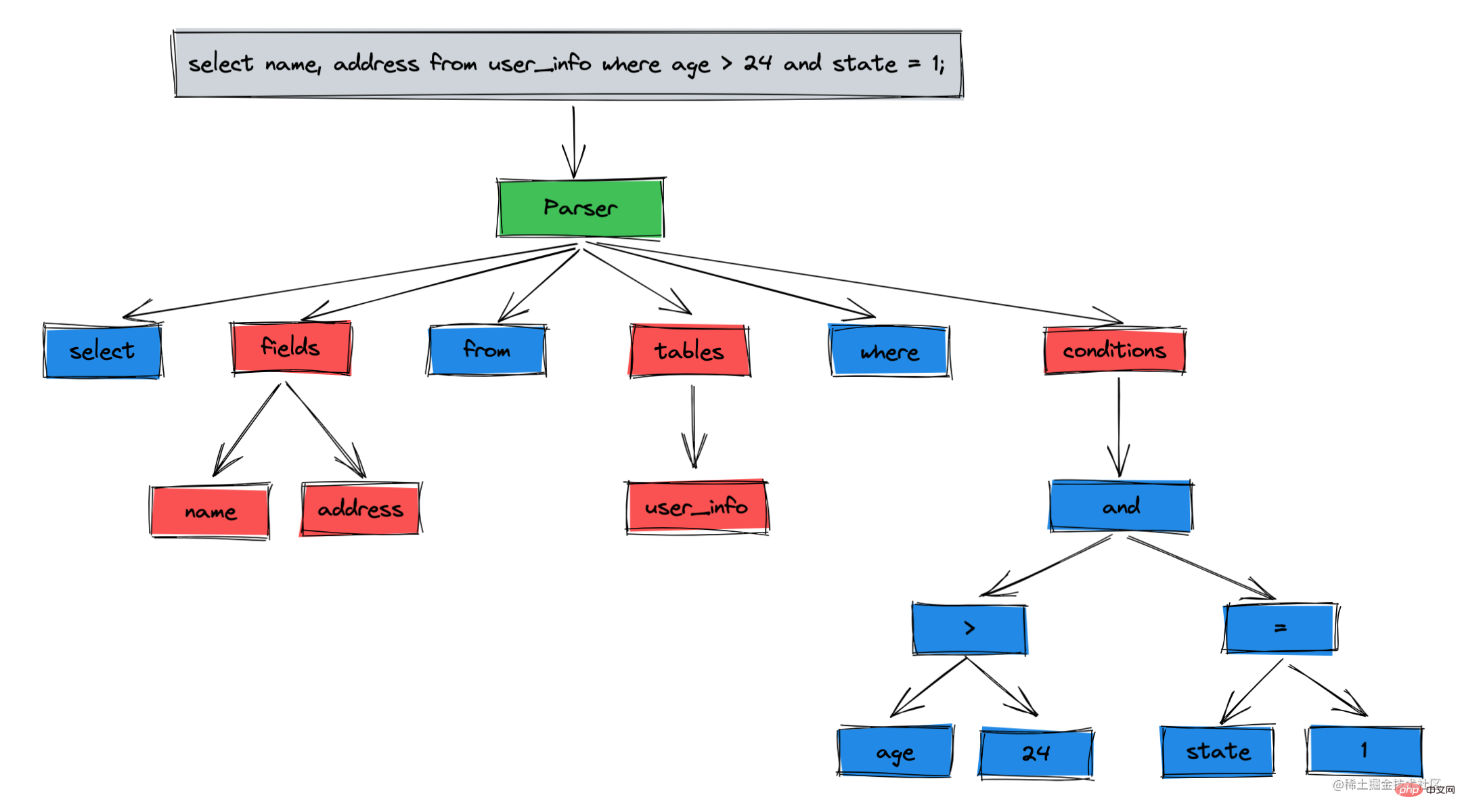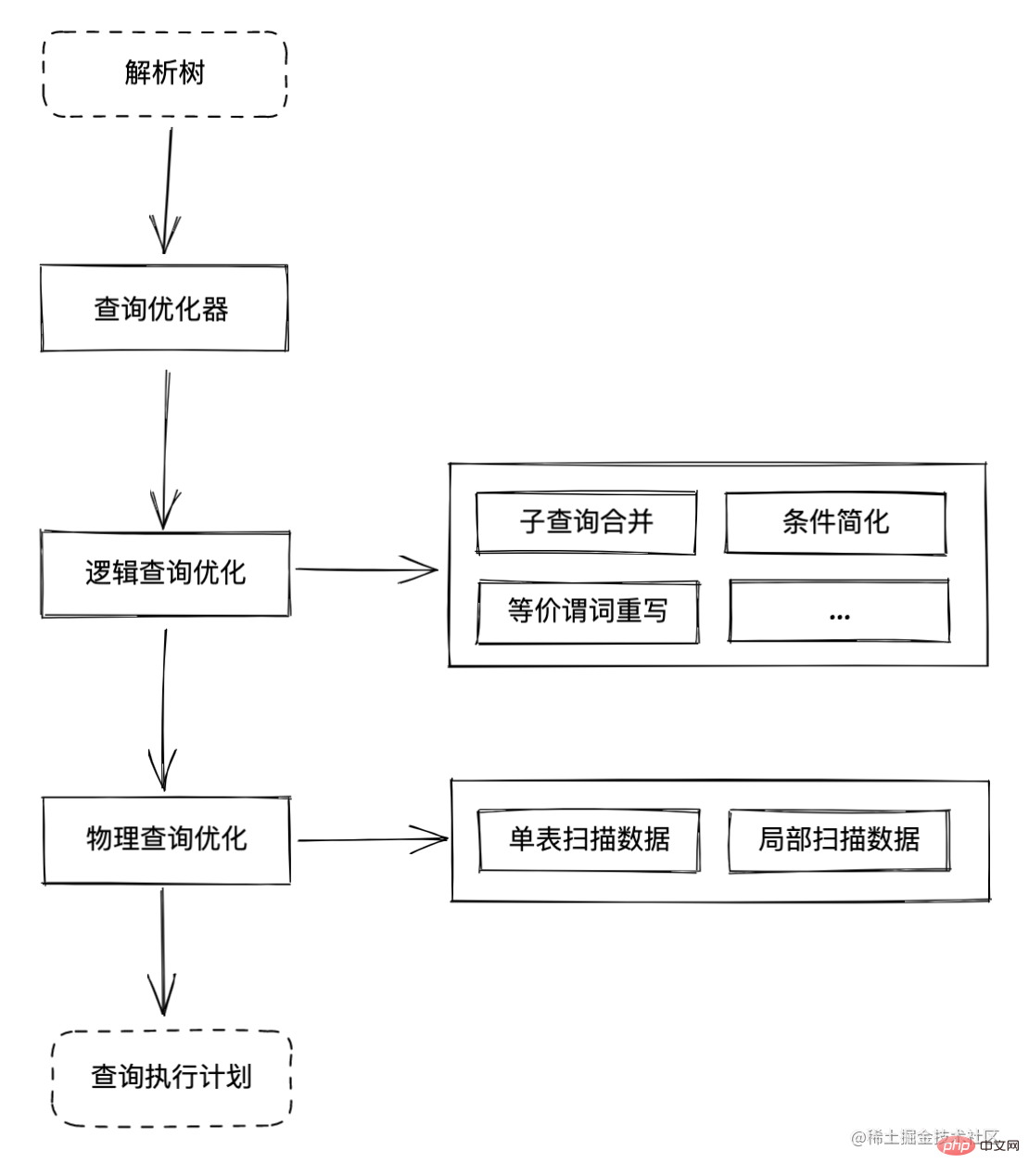MySQL learning to talk about query statement execution process
If you want to learn MySQL in depth, you should start from the macro architecture. In this article, we will learn the process of executing MySQL query statements. I hope it will be helpful to everyone!

The MySQL version of this article is 8.0.18
Architecture diagram

Parser
The function of the parser is to perform the following work on the SQL statement sent from the client:
- Grammar Parsing: Check the syntax of the SQL statement, whether the brackets and quotation marks are closed, etc.
- Lexical parsing: Split the keywords, table names, and field names in the SQL statement into nodes, and finally obtain a parse tree

Preprocessor
The parser mainly checks the grammar and lexicon, but if the grammar and lexicon are correct, but the table , the field does not exist, then this SQL statement cannot be executed correctly.
So the role of the preprocessor is: Semantic parsing, to determine whether the semantics of the parse tree is correct and whether tables and fields exist. After preprocessing, a new parse tree will be obtained.
Query optimizer
Query optimizer structure

The execution method of a SQL statement in MySQL is as follows Although the same results will be obtained in the end, there are differences in overhead. The specific execution method chosen is determined by the query optimizer. For example:
- There are multiple indexes in the table that can be selected. Which index should be selected?
- When we perform related queries on multiple tables, which table’s data should be used? For the benchmark table
The query optimizer is a cost-based optimizer. Its working principle is to evaluate various execution plans based on the parse tree. The cost required for the execution method, will eventually get an execution plan with the minimum cost as the final solution .
However, this execution method with the smallest overhead is not necessarily the optimal execution method. For example, an index should be used, but a full table scan is performed. Although there are two words "optimization" in the query optimizer, this optimization is not omnipotent. In many cases, it is more necessary to consider whether the SQL statement is written reasonably.
Logical query optimization
Logical query optimization is mainly responsible for performing some relational algebra to optimize SQL statements, thereby making SQL statement execution more efficient
We can use several cases to briefly understand logical query optimization
-
Subquery merging
Before merging
SELECT * FROM t1 WHERE a1<10 AND ( EXISTS(SELECT a2 FROM t2 WHERE t2.a2<5 AND t2.b2=1) OR EXISTS(SELECT a2 FROM t2 WHERE t2.a2<5 AND t2.b2=2) );
Copy after loginAfter merging
SELECT * FROM t1 WHERE a1<10 AND ( EXISTS(SELECT a2 FROM t2 WHERE t2.a2<5 AND (t2.b2=1 OR t2.b2=2) );
Copy after loginMerge multiple subqueries by merging query conditions, and reduce multiple connection operations to a single table scan and a single connection
Equivalent predicate rewriting
Like the familiar like fuzzy query, % is written after the condition before the index range query is performed. In fact, this is the credit of the query optimizer
Assume that the conditions used are all indexed, before rewriting
SELECT * FROM USERINFO WHERE name LIKE 'Abc%';
Copy after loginAfter rewriting
SELECT * FROM USERINFO WHERE name >= 'Abc' AND name < 'Abd';
Copy after loginThis is why the answer to index range query
-
Conditional simplification
Conditional simplification is also used Some equations and algebraic relationships are used to achieve simplification
- Remove redundant brackets in expressions and reduce the levels of AND and OR trees generated during syntax analysis, such as
((a AND b) AND (c AND d))is simplified toa AND b AND c AND d - Constant transfer, such as
col1 = col2 AND col2 = 3is simplified tocol1 = 3 AND col2 = 3 - Expression calculation, some expressions that can be directly solved will be converted into the final calculation result, such as
col1 = 1 2Simplification Forcol1 = 3
- Remove redundant brackets in expressions and reduce the levels of AND and OR trees generated during syntax analysis, such as
##Physical query optimization
The main work of physical query optimization is based on SQL Statements evaluate the cost of multiple execution plans respectivelyPhysical query optimization mainly solves the following problems:- Which method is the least expensive in single table scanning? (scan index back to table or full table scan)
- When there is a table connection, which connection method is the least expensive to use
| Cost evaluation formula | |
|---|---|
| N_page * a_page_IO_time N_tuple * a_tuple_CPU_time | |
| C_index N_page_index * a_page_IO_time |
The above is the detailed content of MySQL learning to talk about query statement execution process. For more information, please follow other related articles on the PHP Chinese website!

Hot AI Tools

Undresser.AI Undress
AI-powered app for creating realistic nude photos

AI Clothes Remover
Online AI tool for removing clothes from photos.

Undress AI Tool
Undress images for free

Clothoff.io
AI clothes remover

Video Face Swap
Swap faces in any video effortlessly with our completely free AI face swap tool!

Hot Article

Hot Tools

Notepad++7.3.1
Easy-to-use and free code editor

SublimeText3 Chinese version
Chinese version, very easy to use

Zend Studio 13.0.1
Powerful PHP integrated development environment

Dreamweaver CS6
Visual web development tools

SublimeText3 Mac version
God-level code editing software (SublimeText3)

Hot Topics
 1666
1666
 14
14
 1425
1425
 52
52
 1324
1324
 25
25
 1272
1272
 29
29
 1251
1251
 24
24
 MySQL and phpMyAdmin: Core Features and Functions
Apr 22, 2025 am 12:12 AM
MySQL and phpMyAdmin: Core Features and Functions
Apr 22, 2025 am 12:12 AM
MySQL and phpMyAdmin are powerful database management tools. 1) MySQL is used to create databases and tables, and to execute DML and SQL queries. 2) phpMyAdmin provides an intuitive interface for database management, table structure management, data operations and user permission management.
 Oracle's Role in the Business World
Apr 23, 2025 am 12:01 AM
Oracle's Role in the Business World
Apr 23, 2025 am 12:01 AM
Oracle is not only a database company, but also a leader in cloud computing and ERP systems. 1. Oracle provides comprehensive solutions from database to cloud services and ERP systems. 2. OracleCloud challenges AWS and Azure, providing IaaS, PaaS and SaaS services. 3. Oracle's ERP systems such as E-BusinessSuite and FusionApplications help enterprises optimize operations.
 Explain the purpose of foreign keys in MySQL.
Apr 25, 2025 am 12:17 AM
Explain the purpose of foreign keys in MySQL.
Apr 25, 2025 am 12:17 AM
In MySQL, the function of foreign keys is to establish the relationship between tables and ensure the consistency and integrity of the data. Foreign keys maintain the effectiveness of data through reference integrity checks and cascading operations. Pay attention to performance optimization and avoid common errors when using them.
 Compare and contrast MySQL and MariaDB.
Apr 26, 2025 am 12:08 AM
Compare and contrast MySQL and MariaDB.
Apr 26, 2025 am 12:08 AM
The main difference between MySQL and MariaDB is performance, functionality and license: 1. MySQL is developed by Oracle, and MariaDB is its fork. 2. MariaDB may perform better in high load environments. 3.MariaDB provides more storage engines and functions. 4.MySQL adopts a dual license, and MariaDB is completely open source. The existing infrastructure, performance requirements, functional requirements and license costs should be taken into account when choosing.
 SQL vs. MySQL: Clarifying the Relationship Between the Two
Apr 24, 2025 am 12:02 AM
SQL vs. MySQL: Clarifying the Relationship Between the Two
Apr 24, 2025 am 12:02 AM
SQL is a standard language for managing relational databases, while MySQL is a database management system that uses SQL. SQL defines ways to interact with a database, including CRUD operations, while MySQL implements the SQL standard and provides additional features such as stored procedures and triggers.
 Redis: Understanding Its Architecture and Purpose
Apr 26, 2025 am 12:11 AM
Redis: Understanding Its Architecture and Purpose
Apr 26, 2025 am 12:11 AM
Redis is a memory data structure storage system, mainly used as a database, cache and message broker. Its core features include single-threaded model, I/O multiplexing, persistence mechanism, replication and clustering functions. Redis is commonly used in practical applications for caching, session storage, and message queues. It can significantly improve its performance by selecting the right data structure, using pipelines and transactions, and monitoring and tuning.
 How to safely store JavaScript objects containing functions and regular expressions to a database and restore?
Apr 19, 2025 pm 11:09 PM
How to safely store JavaScript objects containing functions and regular expressions to a database and restore?
Apr 19, 2025 pm 11:09 PM
Safely handle functions and regular expressions in JSON In front-end development, JavaScript is often required...
 MySQL: The Database, phpMyAdmin: The Management Interface
Apr 29, 2025 am 12:44 AM
MySQL: The Database, phpMyAdmin: The Management Interface
Apr 29, 2025 am 12:44 AM
MySQL and phpMyAdmin can be effectively managed through the following steps: 1. Create and delete database: Just click in phpMyAdmin to complete. 2. Manage tables: You can create tables, modify structures, and add indexes. 3. Data operation: Supports inserting, updating, deleting data and executing SQL queries. 4. Import and export data: Supports SQL, CSV, XML and other formats. 5. Optimization and monitoring: Use the OPTIMIZETABLE command to optimize tables and use query analyzers and monitoring tools to solve performance problems.




